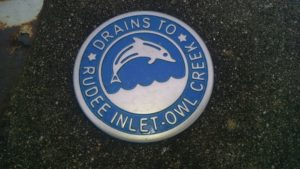Want to get involved?
The Rudee Inlet Foundation (RIF), along with our partners,
is active in several initiatives throughout the watershed.
 Clean the Creek
Clean the Creek
Several times per year, volunteers meet at various locations in the watershed to remove trash and debris from the Rudee Inlet and Owls Creek waterways and shorelines. In collaboration with the Virginia Aquarium and other partners, you’ll have a chance to clean the watershed by walking the shorelines or using a boat, paddleboard or kayak to collect trash. With the support of many volunteers, the RIF has historically removed more than 1,500 pounds of bottles, cans, boat and car parts, Styrofoam, fishing line and other debris from the watershed each year.
 Stormwater Drain Marking
Stormwater Drain Marking
In partnership with the City of Virginia Beach’s Stormwater Drain Marking Program, RIF volunteers have installed hundreds of markers on existing stormwater drains and inlets since the project’s inception in 2012. Water that runs off streets and buildings picks up litter, motor oil, excess fertilizers, pet waste, yard clippings, and other contaminants. The markers provide a visual reminder that what is placed into the storm drain system ultimately runs into Owls Creek, Rudee Inlet and the Atlantic Ocean.
 Sanctuary Oyster Reef
Sanctuary Oyster Reef
In 2015, the RIF provided funding and volunteers for installation of the first sanctuary oyster reef in the Rudee Inlet/Owls Creek watershed. The new Owls Creek Oyster Reef at the Virginia Aquarium is designated a “sanctuary reef” as the oysters grown on the reef will never be harvested for human consumption. The reef has three sections: (1) a shoreline fringing section constructed in the intertidal zone with natural oyster shells; (2) a second intertidal section constructed with interlocking concrete blocks called “oyster castles”; and (3) a sub-tidal section composed of a fringing reef and large area of shells layered on the bottom. Young oysters were placed on the new reef by local elementary school students who also raised them. The new Owls Creek Oyster Reef is located adjacent to a boardwalk at the Aquarium and can be viewed by Aquarium guests and recreational vessels. Educational signage on the boardwalk provides guests with information about reef construction and the oyster as a keystone species.
